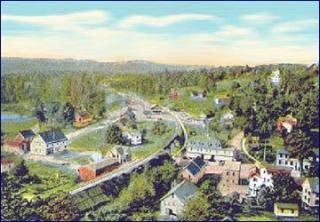Village Center Revitalization Assessment: Summary Report Introduction

Decades ago, the Town identified East Hampton’s Village Center as the area it wanted to focus on as its business and civic hub. Its 1968 Plan sums up the development philosophy which still holds relevance today:
There are substantial regional shopping centers now in Hartford and Middletown, within increasingly easy access of East Hampton, so the need for land for this type of facility is questionable. There is a need now, for retail and commercial facilities to serve the Town, and as the town grows, more space, as well as greater variety of goods and services will be needed. It is more convenient for shoppers, as well as more advantageous for the merchants, if expansion is concentrated in a planned center, rather than strung out along highways or spotted here and there over the town.
This commitment to create a vibrant, economically viable town center has been repeated in subsequent planning efforts including a 1990 East Hampton Village Center Revitalization Study prepared for the Economic Development Commission and the draft 2006 Plan of Conservation and Development. In spite of longstanding and widespread support for revitalization, implementation of targeted zoning provisions and town acquisition of several properties as a means for jumpstarting reinvestment, the Center has not yet achieved the hoped for goals in terms of economic revitalization.
The prominence of old mill stock and the stigma of unknown environmental conditions associated with the mill sites is currently a key issue needing to be addressed before the Town can realistically expect substantial private investment to flow into the Center. The Town acknowledged the importance of these issues, applied for and secured Federal Brownfields funding to begin investigating the environmental impacts related to our industrial past. The Town’s Economic Development Commission (EDC) formed a Brownfields Steering Sub-Committee to guide the efforts and the sub-committee began the process of managing The Village Center Brownfields Revitalization Initiative. It was hoped that a Brownfield Assessment Grant from the U. S. Environmental Protection Agency would not only identify environmental hurdles to redevelopment, but would provide strategies and an action plan to move redevelopment forward.
An interdisciplinary team of professionals was assembled under the Steering Sub-Committee to guide the implementation of the grant, to examine the initial redevelopment potential of the Village Center, and to develop realistic strategies for implementation. The Steering Sub-Committee assembled an inventory of potential brownfields in the Village Center (summarized in Table 1 and shown on Figure 1) and conducted Phase I and Phase II Environmental Site Assessments of Town-owned brownfields properties. Appendix A includes site information from public records on each of the properties. The Steering Sub-committee felt strongly about identifying sustainable uses that were consistent with the Town’s overall goals for the Village Center. To aid the determination of practical, sustainable uses of potential brownfields properties, the Sub-committee commissioned an evaluation of market and real estate conditions. This report summarizes the analyses performed and presents recommendations to assist the Town in reaching its ultimate goal of revitalizing East Hampton’s Village Center.
Summary Report Documents
- Complete Summary Report: December 2006
- Appendix A: Site Descriptions
- Figure 1: Site Location
- Table 1: Brownfields Inventory
- Table 2: Site Screening Matrix
Updated: December 28, 2006

